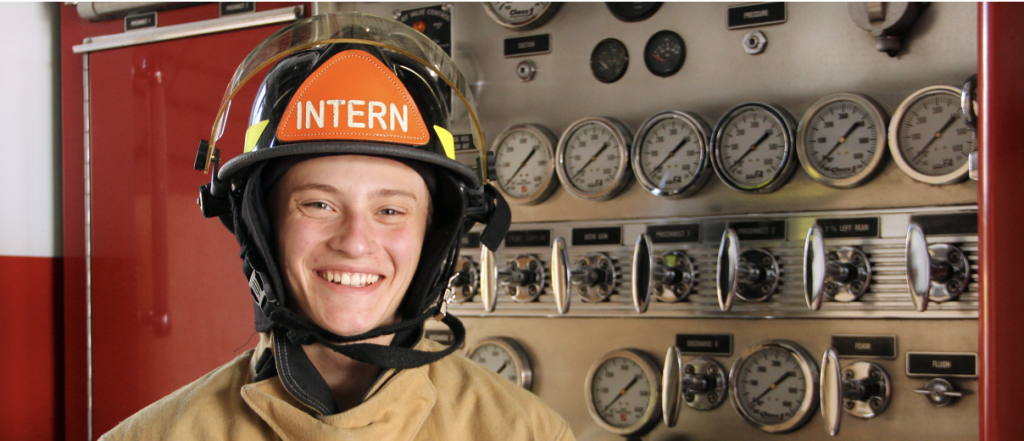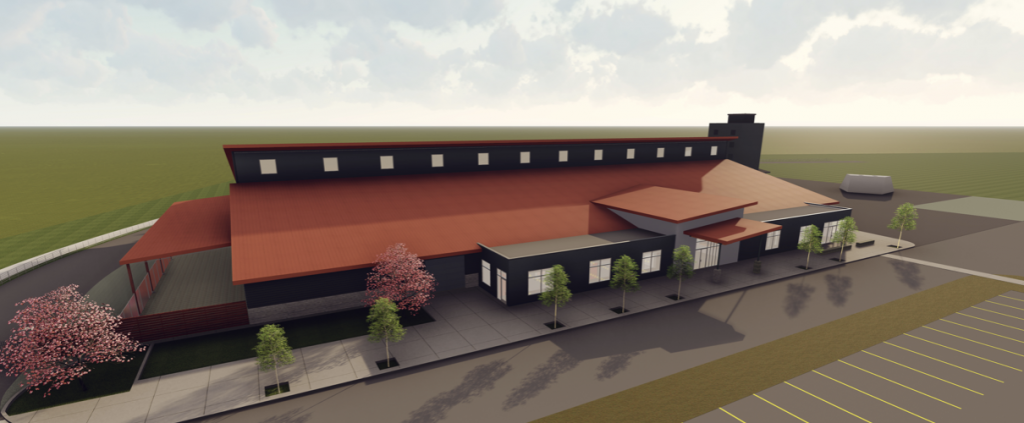Firefighter program provides local education, pathway to professional career

By Lacey Jarrell
Braden Krag’s future is in giving back to his community.
The 18-year-old EagleRidge High School graduate said he is looking forward to one day serving as a structural firefighter for Klamath County Fire District 1 (KCFD1) in Klamath Falls.
Braden is enrolled in the Resident Student Firefighter Program at Klamath Community College. Through the program, students can live at a fire station and learn the ropes of emergency response while pursuing an associate degree.
“They can live there free of charge. They can study,” said KCFD1 Division Chief Devon Brown. “When they are not in the fire academy, they are assigned to one of our shifts. They work one day a week, 24 hours at a time, with the actual full-time crew they are assigned to.”
Krag and three other resident students are assigned to the KCFD1 station near the Running Y Ranch Resort. Krag was assigned to the station in early June, shortly before starting summer classes and the fire academy.

The Resident Student Firefighter Program at KCC is in its second year, and Brown is thrilled that residencies for the four open spots were quickly filled. He pointed out that KCFD1 requires applicants to have a Firefighter 1 certificate from the state and an EMT license before they can apply for jobs with the department.
“A lot of people get their education and training elsewhere. Some come back, some don’t. Some find opportunities outside Klamath Falls and they just don’t return. Luckily, we’ve had good people return to take the jobs here in Klamath Falls at Fire District 1,” Brown said. “We’d like to see more people train here and stay here.”
Fire academy
Resident student Krag and his classmates completed summer basic firefighter academy training in July.
Students are placed with the Keno Fire Department, Fire District 4 in Stewart Lennox, and KCFD1. Brown said students are not required to accept residency to enroll in KCC’s fire and EMS programs. Seven students are currently enrolled in the program; four are residents at fire stations and three are not.
Throughout the fire academy, students participate in a combination of classes at KCC and field exercises, such search and rescue operations and live fire exercises that take place at the station in Stewart Lennox.
“We pretty much learned the basics about the basics,” said Krag, noting that activities included carrying victims, learning about fire behavior and building construction, using fire extinguishers and hydrants, and more.
That could all change though, if KCC’s dream of constructing a multiuse Apprenticeship and Industrial Trades Center is realized. The center is slated to span five acres on the KCC campus and include nearly 12,000 square feet of hands-on training space for students enrolled in industrial trades and apprenticeship programs such as electrical, plumbing, millwright, pipefitter, and machinist. Students enrolled in fire sciences and emergency medical operations programs will have a 3,200-square-foot fire academy for wildland and structural fire instruction.
“KCC’s new trades center and fire training facility will attract applicants from all over the West,” said Charles “Chip” Massie, KCC executive director of external programs and the KCC Foundation. “The growth will undoubtedly create an advantage for our local fire entities and become a driver for economic development in our communities.”
Brown said the apprenticeship center will be a one-stop-shop for current fire science students to learn an array of skills, from performing the basic functions of a firefighter to the chemistry and physics involved in fire theory. The center will also provide potential students with an up-close view of what a career in emergency response entails, he said.
“They are going to see fire engines and people out there doing the training,” Brown said. “Right now the fire program is present on campus, but mainly in a classroom. All the hands-on training is done off-site, so it’s never seen by other students or potential students.
“Once those facilities are there people can see where they can practice throwing ladders; where they can practice on live fire, and where they can learn to operate fire apparatus and fire trucks. They’ll know what a fire station actually looks like.”
Local benefits
According to Brown, in addition to creating a homegrown, emerging workforce, another key benefit of providing local education is opening up opportunities for current emergency responders to receive continuing education and training.
“It’s extremely expensive for a volunteer department to send its people out of county for a training, and it’s hard for people who are volunteering their time to do that,” he said, noting that fire stations in Keno, Chiloquin, Stewart Lennox, Rocky Point, Merrill, Malin, and Bonanza are all staffed solely by volunteers.
Chiloquin Fire and Rescue Chief Mike Cook said having a local facility for training reduces the risks associated with travel, especially in winter months, and provides valuable opportunities for agencies to train with the personnel they work side-by-side with when responding to emergencies.
“Having a local training center will allow us to have good working partnerships with our mutual aid partners, to keep our personnel safe, and to cut costs so money can be spent in other important areas,” Cook said.
Brown said the types of training he hopes to see at the new center will create incentive for local agencies to partner more often and ensure local emergency responders have access to continuing education.
“We can keep our emergency responders here in Klamath County,” Brown said.
Krag said it’s hard to know what the future will hold, but in a perfect world, he would land a paid firefighter position with KCFD1 after he graduates from KCC. Krag said he would like to stay in Klamath Falls near his family, friends, and outdoor hobbies.


Advertisement